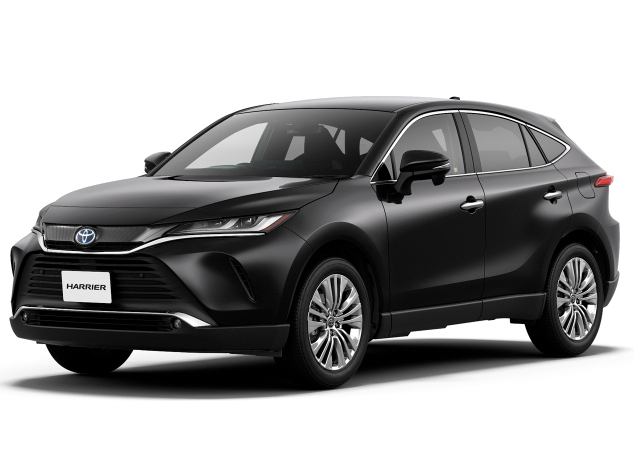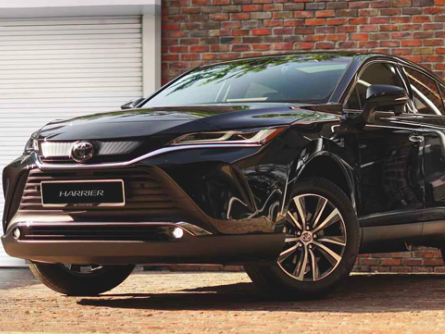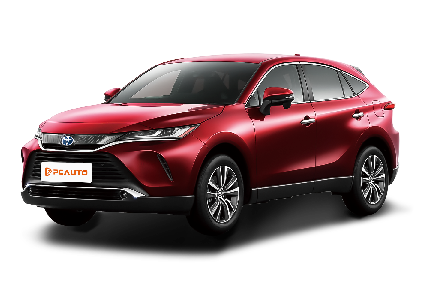Q
toyota harrier how many seater
The Toyota Harrier is positioned as a luxury midsize SUV, currently available in Malaysia as a five-seater with a 2+3 seating configuration, making it ideal for families or business use. The rear cabin offers ample space, and the seats fold down in sections to boost cargo-carrying versatility. What makes the Harrier a hit with local buyers? Its sleek interior design, generous tech features, and reliable powertrains—think the 2.0L naturally aspirated engine or the 2.5L hybrid option. It’s particularly well-suited for Malaysia’s urban jungle and long highway stretches alike.
Here’s an interesting point: the Harrier shares its platform with the Lexus NX but comes in at a more wallet-friendly price point with a slightly less premium positioning. That makes it a solid middle-ground pick for shoppers who want quality without breaking the bank. If you need seven seats, though, Toyota’s got you covered with options like the Fortuner SUV or the Innova MPV. Both are super popular here and backed by Toyota’s extensive after-sales network. When deciding, just weigh up your actual passenger needs and how you’ll use the vehicle—space versus driving feel is the key here.
Special Disclaimer: This content is published by users and does not represent the views or position of PCauto.
Related Q&A
Q
What is the price of Harrier car 2023?
The 2023 Toyota Harrier is priced roughly between RM200,000 and RM250,000 in the local market, with the exact figure depending on trim levels and optional packages. The base model comes with a 2.0-liter naturally aspirated engine, while higher-spec variants get a 2.5-liter hybrid system – both paired with a CVT gearbox, focusing on comfortable driving and fuel efficiency. This midsize SUV is known for its sleek coupe-like exterior and premium interior. Standard features across the range include LED headlamps, a power tailgate, and Toyota's TSS safety suite, which includes active systems like pre-collision warning and lane-keeping assist. The hybrid version also offers an E-Four electronic all-wheel-drive option. It's worth noting that rivals like the Honda CR-V and Mazda CX-5 have lower starting prices, but the Harrier differentiates itself with a larger body and imported status. It also leads in residual value in the used car market. Before buying, it’s advisable to compare promotions from different dealers – some might offer free maintenance packages or low-interest financing deals.
Q
How much is a Toyota Harrier 2023?
The 2023 Toyota Harrier is priced locally between approximately RM200,000 and RM250,000, varying by trim level and configuration. Exact prices may fluctuate depending on dealer promotions or optional accessories. The vehicle offers two powertrain options: a 2.0-liter naturally aspirated engine and a 2.5-liter hybrid system. The hybrid variant stands out for its fuel efficiency, making it ideal for eco-conscious buyers. The Harrier has gained popularity for its sleek exterior design, spacious interior, and generous tech features – like the standard Toyota Safety Sense suite, which includes pre-collision safety, lane departure alert, and other functions. Notably, it shares a platform with the Lexus NX, resulting in a solid driving experience. Recent fluctuations in the Japanese Yen exchange rate could impact import vehicle pricing, so it’s advisable to compare quotes from multiple authorized dealers before purchasing. Keep an eye out for promotional offers or low-interest financing deals too. Besides the Harrier, competitors in the same price range include the Honda CR-V and Mazda CX-5, each with distinct strengths in space, power, or handling.
Q
What is the fuel consumption of the Harrier 2018?
The fuel economy of the 2018 Harrier varies depending on the drivetrain and powertrain configuration. The 2.0L naturally aspirated front-wheel drive version has a combined fuel consumption of approximately 6.8L/100km, while the 2.0L turbocharged all-wheel drive version is slightly higher at around 7.3L/100km. Actual fuel consumption can be affected by driving habits, road conditions, and maintenance status. This vehicle features optimized engine technology and a lightweight body design, which help improve fuel efficiency, and it also comes with an ECO driving mode to further reduce fuel consumption. In daily driving, maintaining smooth acceleration, using cruise control properly, and regularly replacing the air filter can all improve fuel efficiency. It's worth noting that hybrid models are generally more fuel-efficient than traditional gasoline-powered vehicles. If energy conservation is a priority, the hybrid version may be a better choice, but it's necessary to balance the purchase cost with long-term fuel savings.
Q
What is the mileage of Harrier 2018?
The fuel economy of the 2018 Harrier varies by drivetrain and powertrain setup. The 2.0L naturally aspirated front-wheel-drive version has an official combined fuel consumption of approximately 6.8L/100km, while the 2.0T turbocharged all-wheel-drive variant comes in around 7.3L/100km. Actual fuel usage may fluctuate slightly depending on driving habits and road conditions. This midsize SUV features Toyota's proven powertrain, striking a balance between power delivery and fuel efficiency, with its Dynamic Force engine technology achieving energy saving performance through optimized combustion efficiency. If fuel economy is a priority, it's advisable to regularly maintain tire pressure, avoid sudden acceleration and hard braking, and make proper use of the ECO driving mode. Among same level models, hybrid versions typically offer better fuel economy figures but require weighing the difference in purchase costs. It's worth noting that vehicle load and air conditioning usage frequency also significantly impact real-world fuel consumption, so owners are recommended to refer to official data while evaluating based on their own usage scenarios.
Q
What kind of engine is in the 2018 Toyota Harrier?
The 2018 Toyota Harrier offers two engine options depending on the market: a 2.0-liter inline-four naturally aspirated engine (3ZR-FAE) and a 2.5-liter inline-four hybrid system (2AR-FXE). The 2.0-liter engine delivers around 150 horsepower, paired with a CVT transmission, focusing on smoothness and fuel efficiency. The hybrid version combines a 178-horsepower gasoline engine with an electric motor, resulting in a combined output of 197 horsepower and using an E-CVT transmission, making it better suited for users seeking low fuel consumption and a quiet driving experience. Both engines feature Toyota's proven Dual VVT-i variable valve timing technology, optimizing power response and combustion efficiency. As a mid-to-high-end SUV under Toyota, the Harrier's powertrain is tuned for comfort, ideal for city roads and long-distance driving. Notably, the hybrid version is equipped with a nickel-metal hydride battery pack, whose reliability has been market-tested for years with relatively low maintenance costs, while the naturally aspirated version continues Toyota's tradition of engine durability, suitable for consumers valuing practicality. When choosing, consider your daily driving mileage and preferences: the hybrid version offers more significant fuel savings in traffic congestion, while the naturally aspirated version has a slight advantage in later maintenance.
Q
What is the ground clearance of Harrier 2021?
The 2021 Toyota Harrier offers a ground clearance of approximately 190mm in the Malaysian market, a design that balances urban driving comfort with light off-road needs, making it suitable for the country's diverse road conditions. As a mid-size SUV, the Harrier's ride height sits between sedans and traditional off-roaders, ensuring chassis safety when tackling speed bumps or rough surfaces while maintaining a lower center of gravity for improved high-speed stability. It's worth noting that ground clearance can vary slightly based on vehicle load or optional components like sport kits, so owners should regularly check the chassis height to ensure optimal performance. Rivals in the same segment, such as the Honda CR-V or Mazda CX-5, typically have ground clearance ranging from 185mm to 210mm. The Harrier's setup leans more toward on-road driving refinement, though adding a chassis skid plate is advisable for frequent gravel road use. Malaysia's rainy climate also benefits from the higher ground clearance, enhancing water-wading capability, but drivers should note the manufacturer's specified maximum wading depth of 500mm and avoid risky attempts in deep water.
Q
What size tyres are available in Harrier 2021?
The 2021 Toyota Harrier offers different tire sizes in the Malaysian market depending on the trim level. The common spec is 225/60 R18, a size that balances comfort and road adaptability, perfectly matching the Harrier's urban SUV positioning. Some higher-end variants might come with 235/55 R19 for better handling performance. When choosing tires, always check the original factory specifications labeled inside the door jamb or fuel filler cap—it's crucial for ensuring driving safety and optimal performance. Malaysia's tropical climate means frequent rain, so prioritizing all-season tires or high-performance tires with effective rain grooves is recommended, like popular models such as Michelin Primacy 4 or Goodyear EfficientGrip. These tires deliver more stable performance on wet roads. If owners want to upgrade tire sizes, caution is advised—a diameter change exceeding 3% of the original spec could affect odometer accuracy and even cause abnormal wear to the suspension system. It's best to consult a professional tire shop and use a tire size calculator for comparison. Regularly checking tire pressure (including the spare) and tread wear is especially important for extending tire life, and for SUVs like the Harrier, monthly checks are recommended.
Q
What is the TYRE pressure for Harrier 2021?
The standard tire pressure recommendation for the 2021 Toyota Harrier is typically 230 kPa (about 33 psi) for both front and rear tires. However, the exact figures might vary slightly depending on the vehicle's trim level, tire size, or load conditions. It's best to check your owner's manual or the tire pressure label on the driver's door jamb for the most accurate info. With Malaysia's hot weather, tire pressure tends to rise a bit as temperatures go up, so just inflate to the standard value when the tires are cold—no need to adjust right after driving when they're hot. Regularly checking tire pressure not only boosts fuel efficiency and handling stability but also extends tire life. Aim to check at least once a month, and definitely before long road trips. If you often carry heavy loads or have a full car, you can bump up the rear tire pressure by 10-20 kPa to handle the extra weight, but never exceed the maximum pressure marked on the tire sidewall. Digital tire pressure gauges are more accurate than the old-school mechanical ones, and those free pressure checks at gas stations or tire shops are worth taking advantage of too.
Q
What is the acceleration of the Harrier 2021?
The 2021 Toyota Harrier in Malaysia comes with a 2.0-liter naturally aspirated petrol engine that does 0-100 km/h in around 10 seconds. The hybrid version, though, pairs a 2.5-liter engine with an electric motor to cut that time to about 8 seconds—though actual performance can vary slightly based on driving mode, road conditions, and vehicle load. For Malaysian drivers, the Harrier's acceleration is more than enough for daily city commutes and highway cruising. The hybrid model especially benefits from the electric motor's instant torque, making take-offs feel peppy. It’s worth remembering that acceleration isn’t just about engine power; transmission tuning, weight distribution, and tire grip play big roles too. The Harrier’s CVT delivers smooth power delivery, while the TNGA platform’s low center of gravity helps with stability. If you’re after more performance, we’d suggest test-driving both powertrain options. Also, keep an eye on local Malaysian automotive media for real-world test data—those reviews usually factor in how our tropical climate and local fuel quality affect the car’s performance.
Q
How much oil does a Harrier 2021 take?
The 2021 Toyota Harrier has an oil capacity of approximately 4.6 liters for the 2.0-liter naturally aspirated engine, while the 2.5-liter hybrid system requires around 5.7 liters. The exact amount should be confirmed with the owner's manual, as different engine models and whether the oil filter is replaced can affect the quantity. It's recommended to use fully synthetic oil meeting Toyota Genuine oil standards, such as 0W-20 or 5W-30. These low-viscosity oils are suitable for Malaysia's tropical climate and help improve fuel efficiency. Regular oil changes every 10,000 kilometers or 6 months are crucial for maintaining engine life, especially in Malaysia's hot and humid environment where oil tends to oxidize and deteriorate quickly. It's important to note that overfilling with oil can cause abnormal crankcase pressure and damage engine components, so after an oil change, always check the oil level with the dipstick to ensure it's between the MIN and MAX marks. If the vehicle is frequently driven in areas with poor road conditions like Sabah or Sarawak, consider shortening the maintenance interval to 8,000 kilometers and regularly check the oil condition.
Popular Cars
Model Year
Car Compare
Car Photo
Latest Q&A
Q
Is the 1.5 L 4 cylinder?
Yes, a 1.5L engine is typically a 4-cylinder setup—the most common configuration for small to mid-sized displacements. This layout strikes a solid balance between fuel efficiency and power output, making it ideal for daily commuting and family use. Four-cylinder engines are relatively simple in design, cheaper to maintain, and benefit from proven technology that delivers smooth operation. You'll find this configuration widely used by mainstream brands like Honda, Toyota, and Mazda. While there are some 1.5L 3-cylinder options out there, the 4-cylinder remains the go-to choice, especially in models prioritizing durability and refinement. If you're shopping for a 1.5L-powered car, pay attention to specific tech features—turbocharging, direct injection, etc.—as these can significantly impact real-world driving dynamics and fuel economy.
Q
What is the displacement of a V8 engine?
The displacement of a V8 engine typically ranges from 4.0 to 6.2 liters, depending on the vehicle and its purpose. For example, high-performance sports cars often pack a 5.0-liter or larger V8, while trucks and SUVs usually stick with something between 4.3 and 5.7 liters. Known for its brute power and smooth operation, the V8 is a go-to for acceleration and towing—though its thirst for fuel is something buyers always weigh up.
These days, turbocharging has changed the game. Smaller-displacement V8s (like a twin-turbo 4.0L) can now deliver big-block performance with slightly better efficiency. And let’s not forget the sound—few things beat the roar of a tuned V8 exhaust, a big reason why enthusiasts love ‘em.
If you’re into V8s, keep an eye on local used car listings or auto shows—you’ll often spot some gems there.
Q
What is the difference between 1l and 1.2 L engine?
The key difference between 1-liter (1L) and 1.2-liter (1.2L) engines comes down to displacement—the total volume of all cylinders in an engine, measured in liters. Generally, a larger displacement means more power and torque, so a 1.2L engine will likely feel stronger during acceleration, highway driving, or when tackling hills with a load. That said, it’ll also drink a bit more fuel compared to the 1L.
The 1L, being smaller, prioritizes fuel efficiency, making it a smart pick for city commuting or everyday runs. On the flip side, the 1.2L’s extra performance often means higher manufacturing costs, which might bump up the car’s price tag. Plus, the 1L’s compact size fits better in smaller or budget-friendly models.
Your choice really hinges on driving needs: go for the 1.2L if you regularly hit the highway or want more grunt, but stick with the 1L if you’re mostly urban-bound and watching fuel bills. Oh, and don’t forget—tech like turbocharging or variable valve timing can squeeze near-equal performance from smaller engines these days, so specs alone don’t tell the full story. Always check how the engine’s tuned.
Q
What does 5.7 liter engine mean?
A 5.7-liter engine refers to a total displacement of 5.7 liters, meaning all cylinders combine for a total working volume of 5,700 cubic centimeters. Generally, a larger displacement allows the engine to take in more air and fuel, delivering stronger power and torque—making it ideal for performance-oriented vehicles or those built for heavy-duty work, like pickup trucks, full-size SUVs, or muscle cars.
In the local market, you’ll often find big-displacement engines in American-branded vehicles. These engines excel at high-speed cruising or towing heavy loads, though they do come with higher fuel consumption and increased running costs.
Thanks to advancing technology, many automakers now use turbocharging or hybrid systems to help smaller engines deliver power comparable to older, larger naturally aspirated units—like how some modern 2.0L turbocharged engines can match the performance of older V6 engines while being far more fuel-efficient.
If fuel economy is a priority, a smaller turbocharged or hybrid model might be the better choice. But if you value the smooth, raw power of a classic big-block, a 5.7-liter engine remains a timeless option.
Q
What liter engine is a V6?
The displacement of a V6 engine isn't set in stone—it typically ranges between 2.5 and 4.0 liters, depending on the vehicle's design and purpose. For example, a family sedan might pack a 2.5L or 3.0L V6, while performance cars or pickups could go for 3.5L or larger. Displacement directly impacts power output and fuel economy: bigger usually means stronger, but thirstier too.
Named for its six cylinders arranged in a V-shape, the V6 strikes a sweet spot—delivering smoother operation and better balance in a compact package compared to four-cylinder engines, while being more fuel-efficient than V8s. That's why it's a popular choice for midsize sedans and SUVs.
These days, with turbocharging becoming commonplace, smaller-displacement V6 turbos can match the punch of older, bigger engines while sipping less fuel. Choosing one? Think about your daily needs. A 2.5L works fine for city commutes, but if you're frequently hitting the highway or towing, step up to 3.0L or above.
View MoreRelated News

Toyota Harrier: The Perfect Blend of Fuel Efficiency and Premium Comfort
JamesApr 23, 2025

The 2023 Toyota Harrier is priced at RM 274,000, 2.0NA+CVT
LienJul 3, 2024

Will the Toyota Yaris Cross come to Malaysia? If it comes, how much will it sell for?
JamesDec 19, 2025

2026 Toyota HiLux receives five-star ANCAP safety rating in ANCAP
MichaelDec 12, 2025

2026 Toyota bZ4X features a larger battery and longer range but needs to be sold at a lower price
WilliamDec 12, 2025
View More


















Pros
Cons